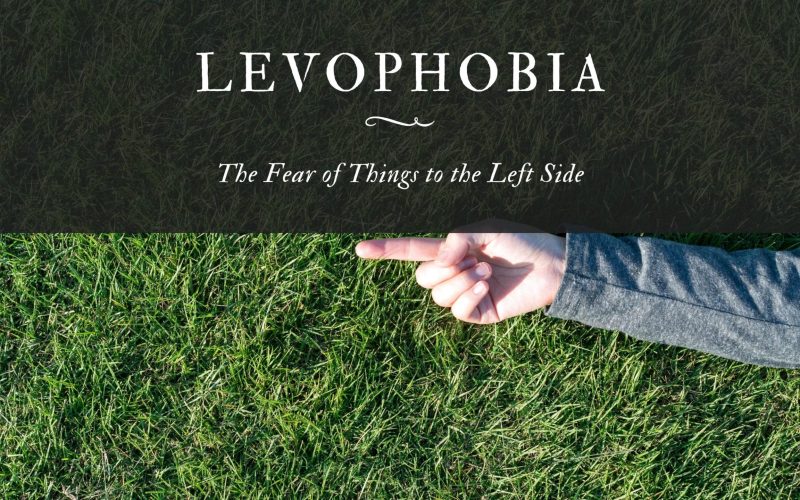People often say that fear is part of life, and in some ways, this statement can be said to be true.
We all have something we are afraid of; however, while some of our fears may be absolutely logical and make sense, others are illogical.
One such fear that can be considered to be irrational is the fear of things that fall to the left side of the body. Are you amazed already? Yes, this kind of phobia exists, and psychologists call this fear Levophobia.
In simpler terms, levophobia can be defined as the irrational fear of things that are mostly found or seen to be on the left side of the body.
Levophobia is derived from two words: Levo(Latin), which means left, and phobia(greek), meaning phobia.
A person suffering from this type of fear can be expected to experience extreme levels of anxiety from either thinking of things that are on the left side of the body or having anything to do with any part on the left side of the body.
Sometimes, the level of anxiety people who suffer from levophobia experience can be so severe that it can result in a full-blown panic attack.
According to scientists, this condition is sporadic. Although it is quite possible for someone who has developed levophobia to have episodes of anxiety when confronted with their fears, not everyone experiences it.
This means that a person can have this fear and be faced with his/her phobia but still not have anxiety. Just as it is common with most phobias, when a person who suffers from levophobia is faced with their fear, they tend to start having anxiety.
When their anxiety causes them to have full-blown panic attacks, they may begin to experience symptoms such as increased breathing rate, increased heart rate, increased blood pressure, uncontrollable sweating, and many more.
Most people with levophobia always try to avoid their fears. Usually, they try to completely avoid anything that has to do with the left side of their body.
Some may even go to extreme lengths by avoiding using their left hands, stretching with their left legs, etc.
Due to their fear, people suffering from levophobia are often hyper-aware of where they are standing and how they are standing.
It is safe to say that people dealing with levophobia are almost always self-conscious as regards their posture and where they are standing.
Their excessive worry and trouble, alongside an irrational way of thinking, are what causes their anxiety disorder. People who have levophobia often, just like others, try to avoid their fear by all means possible.
However, avoidance will only worsen the case as research has shown that the more you avoid your concerns, the more you justify your fears and the more your symptoms.
Causes of Levophobia
Like other specific phobias, levophobia has no known cause. However, scientists have narrowed down the contributing factors into three main categories.
In other words, although there is no known cause yet, there have been some factors that can be seen to contribute to developing levophobia. These factors include:
1. Genetic factors
If a person already has a genetic or family history of anxiety disorders, then the person may likely develop any phobia, including levophobia.
This means that if any member of your family has dealt with any anxiety disorder or mental illness such as schizophrenia and so on, there is a huge tendency for you to develop levophobia easily.
However, it is important to note that the type of phobia or anxiety you develop will most likely be different from that of your parents or family members.
For example, if any of your family members developed limnophobia(fear of lakes), you may develop any other kind of phobia, such as levophobia.
However, although a person has genetic predispositions to developing any specific phobia(such as levophobia) or any anxiety disorder, if their fear isn’t triggered initially, the person may go through life without experiencing any anxiety disorder.
2. Environmental Factors
Before your phobia can start, it has to be triggered. Environmental factors refer to the factors or events that trigger your fears.
Most times, for a person to develop a phobia for a particular thing, an unpleasant event(also known as trauma) may have occurred in the past.
Any emotional event that may somehow be connected to the type of fear can trigger the already predominant genes that the person has and, as such, result in the development of this phobia.
Although both genetic and environmental factors can actually contribute to the develop me of levophobia, however, the exact cause remains unknown.
Symptoms of Levophobia
As is seen with almost all other phobias, the most prominent symptom a person who has levophobia will encounter is anxiety, especially when faced with their fears.
Just as it was mentioned earlier, the levels of anxiety people with levophobia experience differ from person to person.
In some, their anxiety levels may be very minimal, while in others, they may experience severe levels of anxiety such that it may span out into full-blown panic attacks. For some people, their panic attacks can be so severe that they can be hospitalized.
Also, people who have levophobia will go to extreme lengths to avoid their fear. Usually, they are seen putting in lots of effort to ensure they come in contact with their fears.
This also means that they will undoubtedly try to avoid any place in which they might encounter their fear.
In General, people who experience levophobia may exhibit the following symptoms:
- Intense anxiety whenever they think or talk about the left side of their body.
- They always avoid anything that has to do with the left side of the body.
- Often, they are usually unable to cope with their anxiety, and as such, they tend to depend on another person to calm them down.
- They may experience muscle tension, sweating, and intense tremors.
- In some cases, they may experience panic attacks, which come with shortness of breath, uncontrollable sweating, increased pulse rates, increased blood pressure, increased heartbeats, and so on.
Treatment
We have established that there are no known causes of levophobia, and likewise, there are no known treatments specific to levophobia.
However, many different forms of treatment have been seen to help the patient cope with his or her symptoms.
Treatment options that can be used to help manage levophobia include;
1. Exposure Therapy
Exposure therapy is one of the most common forms of treatment that can be used to treat anxiety disorders as well as specific phobias.
As the name implies, exposure therapy involves gradually exposing the patient to their fears until they can get used to them.
People with levophobia tend always to try to avoid their fears. Mostly, they always believe that their fears can cause them harm.
However, with exposure therapy, the patient gradually gets used to their fears, and as a result, they begin to realize that their fears were nothing but fears after all.
When a therapist wants to treat a person who is dealing with levophobia, since their fear has to do with the left side of their body, the therapist may decide to place an object on their left-hand side and ask them to pick it up.
This process is often repeated to desensitize the patient and help them get used to their fears, and as such, over time, their levophobia becomes a thing of the past.
2. Cognitive Behavioral Therapy (CBT)
Cognitive Behavioral Therapy (CBT) is another form of treatment that is commonly used to treat patients who have anxiety disorders, specific phobias or Generalized Anxiety Disorder (GAD), Obsessive-Compulsive Disorder (OCD), and so on.
Generally, CBT is a process used by the therapist to help the patient who has levophobia to understand why he/she thinks the way they do and why they feel and behave the way they do.
This helps the patient understand themselves better, realize that there is a problem with how they think, and help them uncover a pragmatic approach they can take to help themselves, especially when they think of the left side of their bodies.
One of the many aims of CBT is to help patients have a quick subconscious reaction to their fear.
In other words, during CBT, the therapist helps the patient understand that there is nothing more to their fear. As such, when they face their fears, their minds are subconsciously prepared to realize this.
3. The Use of Psychiatric Medications
In some cases, your therapist may have to prescribe certain drugs to help you deal with your fears. Some of these drugs include:
Anti-anxiety Medications
These drugs are to help you deal with your anxiety and panic attacks, reducing them to the barest minimum. Some of these drugs include Xanax, Klonopin, Valium, and so on.
However, it is essential to note that these drugs are not to be taken daily except when your therapist instructs you to.
It is also crucial that you don’t use these drugs without telling your doctor because they can be extremely addictive and harmful if used without the appropriate prescriptions.
Antidepressants
These types of drugs are mostly prescribed for those who are also experiencing signs of depression alongside their levophobia. Your therapists may prescribe some of the common antidepressants such as Zoloft, Lexapro, Paxil, and so on.
Aside from treating depression, these drugs are also capable of treating some of the symptoms of levophobia. Unlike your anti-anxiety medications, antidepressants can be used daily.
This is because these drugs can reduce the person’s daily anxiety and, as such, effectively eliminate the chances of panic attacks. Also, it is essential to let your doctor know about the drugs that you want to take and let him give you adequate prescriptions.
4. Change in Lifestyle
Your therapist will also indicate that you may have a lifestyle change, such as a reduction in caffeine consumption, meditation, engaging in yoga, and exercises that can be quite helpful to those who suffer from levophobia.








